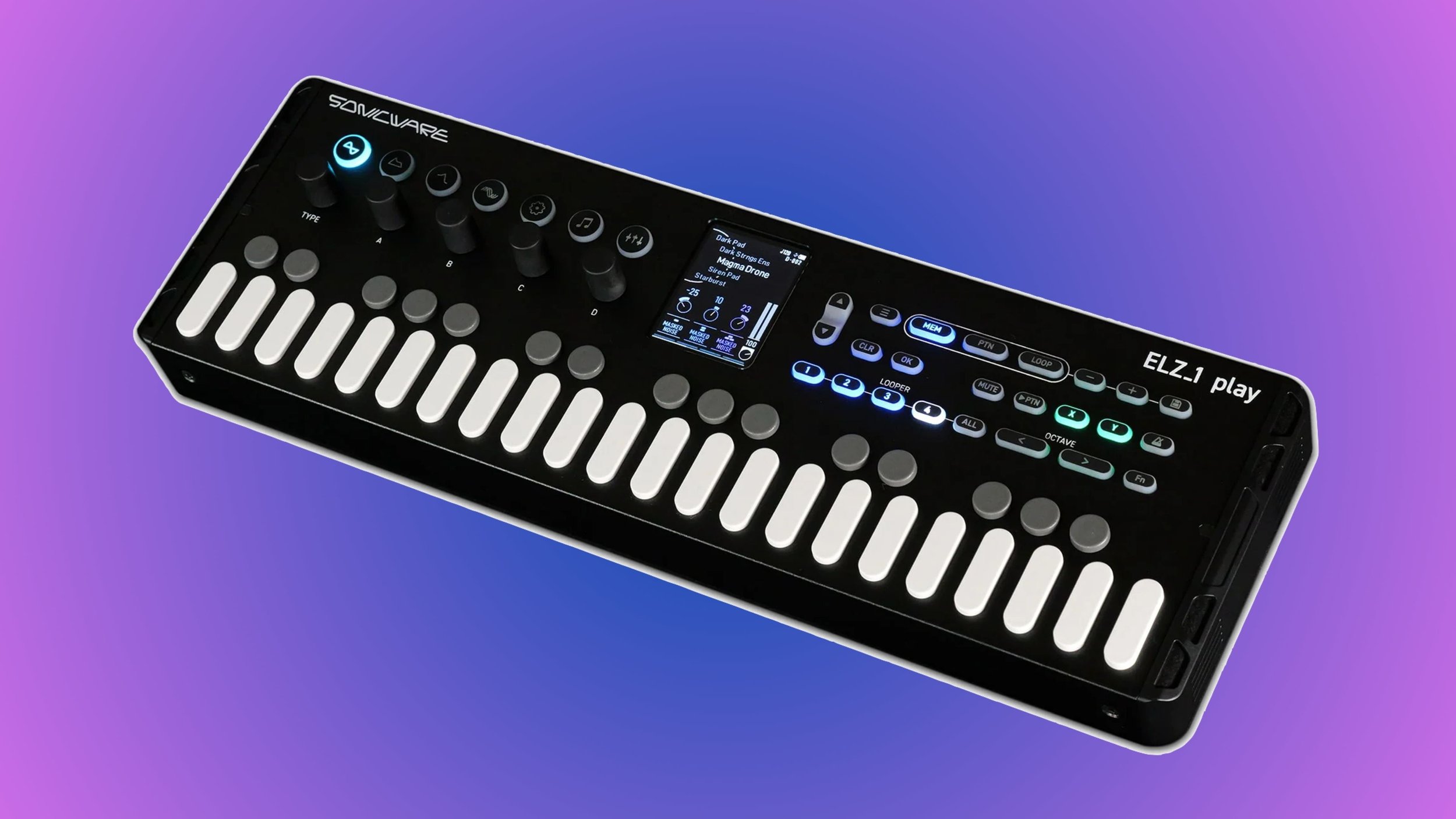ELZ_1 Play v2: Sonicware’s Pocket Powerhouse Gets a Waldorf DNA

The Sonicware ELZ_1 Play v2 feels like the comeback story no one expected but everyone wanted. Originally a quirky side project by Sonicware’s founder, Dr. Yu Endo, the ELZ_1 has slowly grown into a cult favorite for producers who love compact gear with deep synthesis. Now, with the v2 update, Sonicware isn’t just reviving the Play — they’re collaborating with Waldorf, bringing 16 of their legendary wavetables into this tiny powerhouse. In a year full of retro reissues and analog clones, the ELZ_1 Play v2 stands out for doing something genuinely new. It’s portable, experimental, and surprisingly polished. Whether you’re chasing glitchy textures, evolving pads, or digital chaos in your backpack, this update pushes Sonicware’s playful design into serious territory — without losing its charm.
Ready for a fun new synth? Click here to check the current deals on the ELZ_1 v2
This site contains affiliate links. If you book or purchase through these links, I may earn a commission at no extra cost to you. This helps support the site and keeps my content free. As an Amazon Associate, I earn from qualifying purchases.
How We Got Here: From Boutique Curiosity to Cult Classic
The original ELZ_1 landed in that perfect sweet spot for gear obsessives — portable, weird, digital in a way that embraced character instead of chasing pristine “workstation-clean” tone. It won fans because it felt like a love letter to experimental sound design in a handheld form factor. Multiple synthesis engines, quirky UI charm, and a willingness to be playful in a world of serious flagship synths made it stand out. The crowd that loved OP-1 experimentation, SP-404 textures, and pocket-studio workflows quickly realized Sonicware was doing something special: building imaginative tools for musicians who treat synthesis like sketching, not lab work.
Then came the ELZ_1 Play, which took those sound engines and wrapped them in a more loop-focused, performance-friendly workflow. The shift made it feel less like an ultra-deep noodling box and more like a tiny, capable creative workstation. Now, with the v2 update, the story feels complete — refining that vision and elevating it with features you’d normally expect on bigger, pricier instruments. It’s not just an indie passion project anymore; it’s a platform. Sonicware listened, polished, and doubled down on what made this thing special, and the result feels like the ELZ_1 finally stepping into its bigger-league moment.
What’s New & Why It Matters: A Playful Synth Gets Serious Power
The big headline with the ELZ_1 Play v2 is the Waldorf partnership, bringing 16 iconic wavetables directly into this compact unit. That’s a wild development for a synth that started life as a quirky indie project. Suddenly you’ve got digital engines that can move from glassy pads to aggressive shifting timbres — the kind of stuff normally associated with plugin suites or flagship wavetable hardware. Layer that with updated sound engines, expanded modulation, and the clever looper-meets-sequencer workflow, and it becomes clear this isn’t just a firmware polish. It’s a real step forward in how portable digital synths can sound and behave.
But the changes aren’t just sonic. The UI refinements make it feel faster and more fluid to work on, which is huge for a compact, menu-driven instrument. A new Home screen, smoother navigation, and quality-of-life tweaks transform the ELZ_1 Play v2 from an experimental toy into something that feels like a daily driver for sound design sketching and loop-based creation. Sonicware kept the vibe — approachable, playful, slightly off-the-grid — while giving you tools that make the instrument feel trustworthy and serious in a production workflow. It now sits comfortably between “fun portable gadget” and “legitimate creative workstation,” and that balance is what makes this update so exciting.
Sound Engines & Waldorf Wavetables: From Dusty Digital Grit to Futuristic Gloss
The ELZ_1 Play has always been a playground for digital tone — granular textures, FM flavors, quirky oscillators, and bit-crushed atmospheres. With v2, that palette expands meaningfully thanks to the addition of 16 Waldorf wavetables, injecting a new level of depth, movement, and sheen. This isn’t imitation; it’s a genuine collaboration that gives the ELZ_1 Play access to the same DNA that shaped modern wavetable synthesis culture. Pads evolve, basses shimmer and growl, and rhythmic timbres morph with a sophistication that belies the instrument’s size.
Yet what keeps it compelling is how this machine treats digital not as a pristine science experiment but as something tactile and slightly imperfect. Those wavetables can sound lush and cinematic, sure, but they can just as quickly dissolve into crunchy, glitchy artifacts or warm, lo-fi motion. You can sit comfortably in clean synth-pop territory — or push into vaporous noise, playful chaos, and “broken computer dreamscape” textures. The v2 doesn’t just add new engines — it broadens the emotional and aesthetic space the ELZ_1 Play can occupy. This is digital that feels alive, curious, and modern without losing the wonky charm people fell in love with.
One standout new trick for sound-design nerds is the ability to import Serum-format wavetables, meaning you can bring your own custom sound library from the plugin world into this tiny hardware box. It’s a subtle feature with huge creative implications — suddenly the ELZ_1 Play isn’t just generating its own tones; it’s becoming a portable extension of your software workflow. For producers who develop their sonic identity in the DAW but want a playful, go-anywhere instrument, this makes the v2 feel like a legit bridge between laptop and hardware worlds.
Workflow, Loops & Layering: A Pocket Studio Built for Ideas, Not Menus
What makes the ELZ_1 Play v2 click isn’t just the sound — it’s the way you move through ideas. Sonicware didn’t try to over-engineer a “mini DAW” here; instead, they doubled down on immediacy. The four-track loop recorder, lightweight sequencer, and updated Home screen make it feel like you’re sketching musical thoughts rather than managing a project. You jump from sound design to looping to performance without the mental overhead that usually comes with button-dense hardware. This is the kind of machine that encourages mistakes, happy accidents, and those ten-second sparks that eventually turn into full tracks.
The new Layer mode is where it really breathes. Stacking engines and blending tones unlocks a surprising amount of sonic weight, especially considering the size of the device. Tight rhythmic loops, evolving ambient stacks, cutting digital leads — they all feel doable without menu-hunting or losing momentum. This is a rare portable box that doesn’t punish curiosity. You can noodle, you can perform, you can build loops on the bus or in a cabin somewhere. It’s not trying to replace your DAW; it’s helping you catch the moments that would otherwise slip away.
Alternatives to Consider: Other Pocket-Sized Sound Explorers
If you’re drawn to compact gear that blurs the line between sketchpad and serious instrument, the landscape has grown rich. The Teenage Engineering OP-1 Field still reigns as the all-in-one portable studio dream machine — pristine, polished, and famously expensive. It offers a similarly playful approach but leans toward refined sampling, tape workflows, and cinematic sound design rather than the ELZ_1’s digital experimentation. On the other end, the Dirtywave M8 brings tracker-style precision and chip-music punch; it’s more technical, less whimsical, but unbeatable for structured composition on the go.
Then there’s the Roland S-1 Tweak Synth, another pint-sized box with a bold digital edge, though its focus leans toward classic Roland tones and rave-ready leads rather than this kind of hybrid wavetable grit. And if you want pocket-friendly sound design with a modular mindset, the 1010music Lemondrop gives you granular power in a tiny shell. None of these feel redundant next to the ELZ_1 Play v2 — they each attack portable creativity from different angles. Sonicware’s latest earns its place among them by choosing personality over prestige, offering depth without losing the sense of wonder.
Pros & Cons
Pros
16 Waldorf wavetables add real sonic depth and professional polish.
Improved UI and Home screen make navigation smoother and faster.
Layer mode dramatically expands sound design possibilities.
Four-track looper/sequencer enables quick idea sketching and live looping.
Compact and lightweight, perfect for portable setups and travel.
Retains the quirky, characterful sound that made the original beloved.
Strong build and thoughtful layout for such a small form factor.
Cons
Still menu-driven at times, which can slow deep editing.
Limited polyphony and sequencing power compared to larger workstations.
Small screen and buttons may feel cramped for long sessions.
No analog warmth — its sound is distinctly digital (which may divide users).
Some features overlap with firmware updates for older models, making the upgrade decision tricky for existing owners.
Verdict: Built for Play, Ready for Work
The ELZ_1 Play v2 feels like one of those instruments that quietly sneaks into studios and backpacks until you can’t imagine not having it around. It’s not pretending to be a flagship workstation or DAW replacement — instead, it builds a space where playfulness and depth naturally coexist. You can spend hours sculpting evolving digital tones or loop a quick sketch between gigs. The Waldorf wavetables give it unexpected polish, the improved UI makes tinkering effortless, and the compact design keeps creativity within arm’s reach.
This is a synth for curious creators — people who treat sound design like sketching, not drafting blueprints. If you love pocket gear, spontaneous ideas, and tools that reward exploration, it fits right into your world. Ambient producers, beat-makers, and experimental pop artists will find it endlessly inspiring. Paired with a laptop, groovebox, or even just headphones, it’s a genuine creative companion. The ELZ_1 Play v2 still carries that indie charm — slightly off-center, personal, and joyful — but now it feels truly mature. It’s proof that the most inspiring instruments aren’t always big, analog, or expensive; sometimes, they’re the small ones that make you want to start.
Ready for a fun new synth? Click here to check the current deals on the ELZ_1 v2
This site contains affiliate links. If you book or purchase through these links, I may earn a commission at no extra cost to you. This helps support the site and keeps my content free. As an Amazon Associate, I earn from qualifying purchases.



